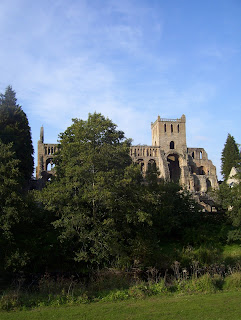 |
| First stop: the 7th century Ruthwell Cross, 18 feet high, showing here the depiction of Christ glorified and some decorative carvings of wild creatures eating berries: |
 |
| On to Whithorn and time for reflection in the remains of the priory near the bay where early pilgrims used to land to follow in the steps of St Ninian |
 |
| Ferry from Oban to Mull... |
 |
| and then an hour on the bus across Mull... |
 |
| ...to catch the smaller ferry to Iona... |
 |
| ...with only one vehicle on the car deck. |
 |
| Looking over the sound to Mull from the garden of Bishop's House where we stayed on Iona |
 |
| Sunrise on Iona |
 |
| Peeping into the 13th century Nunnery |
 |
| A walk to the North End of the island |
 |
| passing Dun I (pronounced dunEE, meaning "Island hill") |
 |
| 102 metres (approximately 300 feet) above sea level From the Abbey the dot of the cairn is just visible (if you trace a line upwards from the second fence post) |
 |
| views from the track up Dun I |
 |
| An expanding view from the track but... |
Down between the sand dunes
to the North End beach
Shingle on the beach
containing a wonderful variety of tiny pebbles
Now it's time to visit Iona Abbey, a mediaeval building restored in the twentieth century, on the site of St Columba's community of monks.
The view from the mound on which Columba is thought to have had his writing hut.
I can imagine sitting here gazing out across the sound when pausing to consider the next sentence. But I think Columba was mainly scribing beautiful copies of important manuscripts, possibly including the Book of Kells.
Below this vantage point is a high Cross which has stood on this spot for 1200 years: St Martin's Cross was carved out of a single piece of stone and is the only intact cross to survive from the eighth century.
Looking out from a prayer cell in the abbey
Setting out for a pilgrimage walk to St Columba's Bay, we passed an erratic boulder (left by a receding glacier)
The golf course is on common land where islanders graze their stock. We paused to think about community life.
 |
| The west shore at the edge of the common |
Southwards, over some rougher ground we came to Loch Staonaig, which was until recently the source of all fresh water for the island. Three migrating swans have paused on the further pool. After our pause, we continued south to St Columba's Bay where a seal popped up to observe us:
 |
| We spent a long time admiring the miraculous pebbles and searching for Iona marble fragments and other colours: |
After our sandwiches it was time to make our way back up the track away from the bay.
The mist had cleared...
...and the swans (three white dots on the further pool) were still resting on Iona:
A time for silence in the sun
The cattle congregate,
the people meet,
and we walk on back to the village.
A window in the chapel of Bishop's House
Looking across to Mull from the Abbey in the evening
looking back at the Abbey from the ferry the next morning
After a pilgrims' Eucharist with the Bishop in Oban Cathedral
On our return to the Borders we visited Old Melrose, the site of the Abbey founded by Aidan which Cuthbert entered in the seventh century (651 AD).
Looking down to the River Tweed which bends here to make a peninsula on which the monastery was enclosed for tranquillity and protected from attack.
Home past Jedburgh
Suggestions for the next pilgrimage destination for a group from Bellingham Deanery are welcome!




















































Great photos. Wish I'd been there!
ReplyDeleteWe'll let you know where we're going next time and you can both come along!
Delete